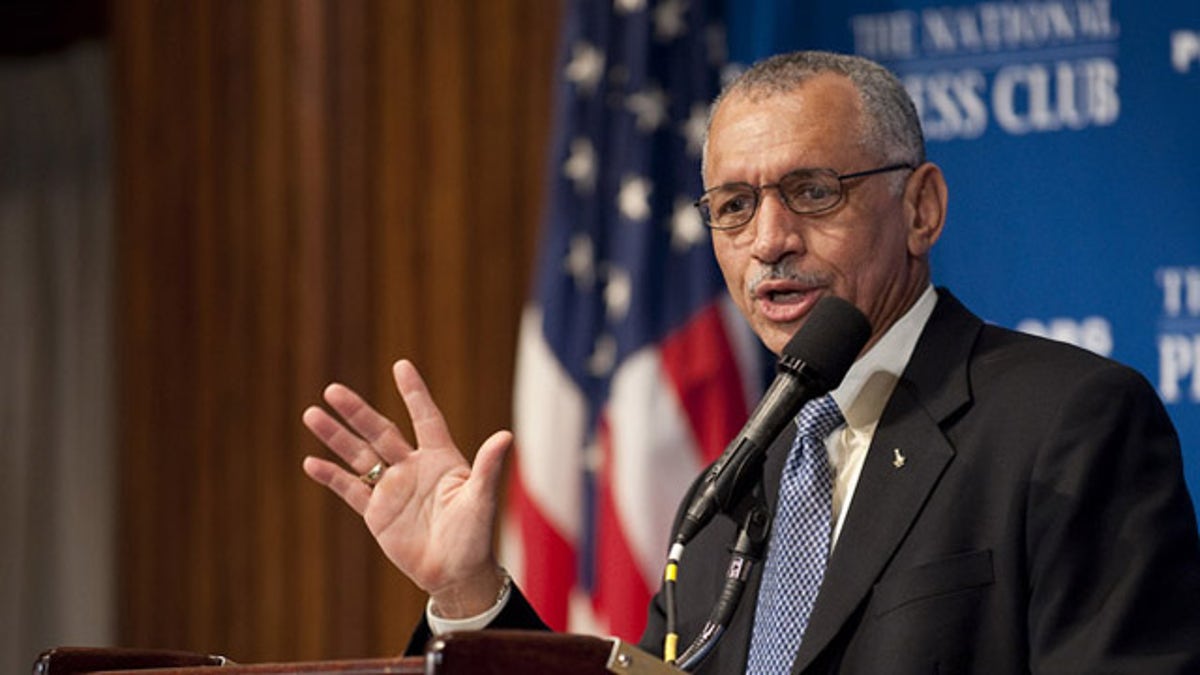
NASA Administrator Charles Bolden speaks during a press conference, Tuesday, Feb. 2, 2010, at the National Press Club in Washington, where the it was announced that NASA has awarded $50 million through funded agreements to further the commercial sector's capability to support transport of crew to and from low Earth orbit. (NASA/Bill Ingalls)
NASA chief Charles Bolden told senators Wednesday that sending astronauts to Mars is still the ultimate goal for U.S. human spaceflight, as he defended the agency's new space plan against criticism in a heated budget hearing.
"Mars is what I believe to be the ultimate destination for human exploration in our solar system," Bolden told the Senate's Commerce, Science and Transportation subcommittee.
But NASA will likely not have the technology to send astronauts to Mars for at least the next 10 years, he said.
"There are too many capabilities that we don't have in our kit bag," Bolden said.
That's where the NASA's 2011 budget request comes in, Bolden said. It sets the stage for future manned spaceflights to the moon, asteroids and Mars, by focusing on the technologies needed to explore beyond low-Earth orbit faster, he added.
But Bolden's comments were met with criticism and, at times, open hostility from some committee members and experts because the new budget request effectively canceled NASA's Constellation program, which was building new rockets and spaceships capable of returning astronauts to the moon.
Without a successor to the space shuttle, NASA will lose talented engineers from layoffs and attrition, which poses a threat to the United States' prowess in human spaceflight, former shuttle commander Robert "Hoot" Gibson told the committee as part of a later hearing with a panel of space experts.
"With the retirement of the space shuttle later this year, and if the administration's proposal is followed, the United States will no longer be a space-faring nation," said Gibson, who flew on five shuttle missions before retiring from spaceflight in 1996.
Next stop for NASA?
While Bolden said Mars is a goal, NASA and the Obama administration have yet to release an official outline for future destinations. That official space plan could take months, agency officials have said.
"You don't accomplish great things without a clearly defined mission," said Sen. David Vitter (R-Louisiana). "And this budget has no clearly defined mission."
NASA's 2011 budget request, released Feb. 1, sets aside $19 billion for the space agency for next year. It is a slight increase from the 2010 budget, and included a life extension through at least 2020 for the International Space Station, as well new funds for space technology development and basic scientific research.
But President Obama's budget assures the retirement of NASA's shuttle program in the fall. In place of NASA-built spaceships to replace them, the budget request would set aside $6 billion over the next five years to support the development of commercial spaceships capable of launching American astronauts.
Sen. Bill Nelson (D-Florida) agreed that President Obama and NASA need to state a clear goal. But the agency must also work to be sure it does not trade astronaut safety for commercially built spacecraft that are cheaper and faster to produce, he added.
"The shift to commercial spaceflight cannot come at the expense of astronaut safety," Nelson said.
Bridging the gap
NASA's three aging space shuttles are due to retire in September after four final missions. After that, American astronauts will be dependent on Russian Soyuz spacecraft to reach the International Space Station during the gap between the shuttle program and when new spacecraft come online.
That gap, Vitter said, is unacceptable and will erode the United States' claim as a leader in space exploration.
"I will fight with every ounce of energy I have to defeat this budget or anything like it," he added.
Vitter asked Bolden how he explained the looming gap, and subsequent job layoffs, to NASA employees who will lose their jobs when the shuttle fleet retires without a successor program.
Bolden, known for his emotions, teared up.
"I can tell them, as I have, that I'm going to do everything in my power to try to make sure that we develop some programs that are going to get to where we all want to go as soon as possible," Bolden said.
That includes funding research into new technologies, including ones to combat radiation and health effects for deep space missions, and others that have the potential to shave months off manned trip to Mars, he added.
"We are oh so close," Bolden said. "But we are not there yet."
Copyright © 2010 Space.com. All Rights Reserved. This material may not be published, broadcast, rewritten or redistributed.
